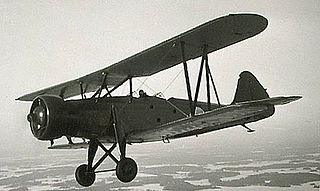The Aero A.18 was a biplane fighter aircraft built in Czechoslovakia in the 1920s. It was a development of the Ae 02 and Ae 04 fighters Aero had designed during World War I, but also borrowed from the more recent A.11 reconnaissance-bomber design.

The Gloster Gamecock was a biplane fighter designed and produced by the British aircraft manufacturer Gloster.

The VL Humu is a Finnish fighter aircraft, designed by Valtion lentokonetehdas in 1944, and based on the American Brewster F2A Buffalo.

The VL Myrsky is a Finnish World War II fighter aircraft originally developed by Valtion lentokonetehdas for the Finnish Air Force. The models of the aircraft were Myrsky I, Myrsky II, and Myrsky III.

The VL Pyörremyrsky ("Hurricane") was a Finnish fighter, designed by DI Torsti Verkkola at the State Aircraft Factory for service with the Finnish Air Force in World War II. The war ended before the type's first flight and only a prototype was built.

The VL Tuisku was a Finnish trainer aircraft designed in the 1930s. It was a two-seat, single-engined biplane with a welded steel framework, covered with fabric. 30 were produced for the Finnish Air Force and served from 1935 to 1949.

VL Pyry was a Finnish low-winged, two-seated fighter trainer aircraft, built by the State Aircraft Factory for use with the Finnish Air Force. The Pyry was in use from 1939 to 1962. The aircraft was a mixed construction of wood, steel, fabric, and duraluminium.

VL Kotka ("Eagle") was a Finnish two-seat, biplane maritime patrol aircraft, designed and built by the Valtion lentokonetehdas or VL. It was meant as a cheaper replacement for the outdated IVL A.22 Hansas that were in service with the Finnish Air Force.

VL Sääski II was the first series-produced aircraft designed in Finland. The aircraft was built by the State Aircraft Factory and was a two-seat, biplane, single-engine trainer constructed out of wood.

Valmet Vihuri was a Finnish advanced two-seat fighter trainer aircraft, serving in the Finnish Air Force between 1953 and 1959. Only a few airframes have survived, as in the Central Finland Aviation Museum in Finland.

The Letov Š-18 was a Czechoslovak single-engined, two-seat biplane trainer. It was designed by Alois Smolík at Letov Kbely. The Š-18 first flew in 1925.

The Valmet Tuuli was a trainer aircraft, developed for the Finnish Air Force by the State Aircraft Factory. The aircraft was to be produced in 3 different versions. The last version, Tuuli III was redesigned from scratch, and is basically an entirely different aircraft.

The Caudron C.59 was a French, two-seat biplane with a single engine and a canvas-covered fuselage, produced between 1922 and 1924. Suitable for a variety of roles, more than 1,800 Caudron C.59s were manufactured.

The Caudron C.60 was a French two-seat biplane of the 1920s and 1930s with a single engine and a canvas-covered fuselage. The French aircraft manufacturer Caudron developed this aircraft from the Caudron C.59. It was mainly used as a trainer aircraft.

IVL C.VI.25 was a Finnish fighter aircraft designed by IVL. It was a further development of the IVL C.24.

IVL K.1 Kurki was a prototype for a four-seated, high-wing trainer aircraft, which was designed in 1927 by IVL. The designer was Asser Järvinen and the prototype was manufactured at the IVL plant at Suomenlinna. The aircraft made its maiden flight on March 30, 1927. Only one aircraft was manufactured.

Valtion lentokonetehdas was a Finnish aircraft manufacturing company that was founded on 23 February 1928 from the IVL or I.V.L. factory, founded in 1921.
Kurt Volmar Berger (1896–1977) was an aviation engineer and the chief designer at the Finnish aircraft manufacturing company Valtion Lentokonetehtaat.

Hansa-Brandenburg W.33 was a German two-seat, single-engined low-wing monoplane floatplane, which had been developed by Hansa und Brandenburgische Flugzeugwerke during World War I as a higher powered enlargement of the similar Hansa-Brandenburg W.29 and despite the increase in size the two types are very difficult to differentiate. Although the W.33 was built in small numbers during the war many license built versions were built after World War I.

The Dewoitine D.19 was a fighter aircraft built in France in 1925 in response to a French Air Force solicitation.


















